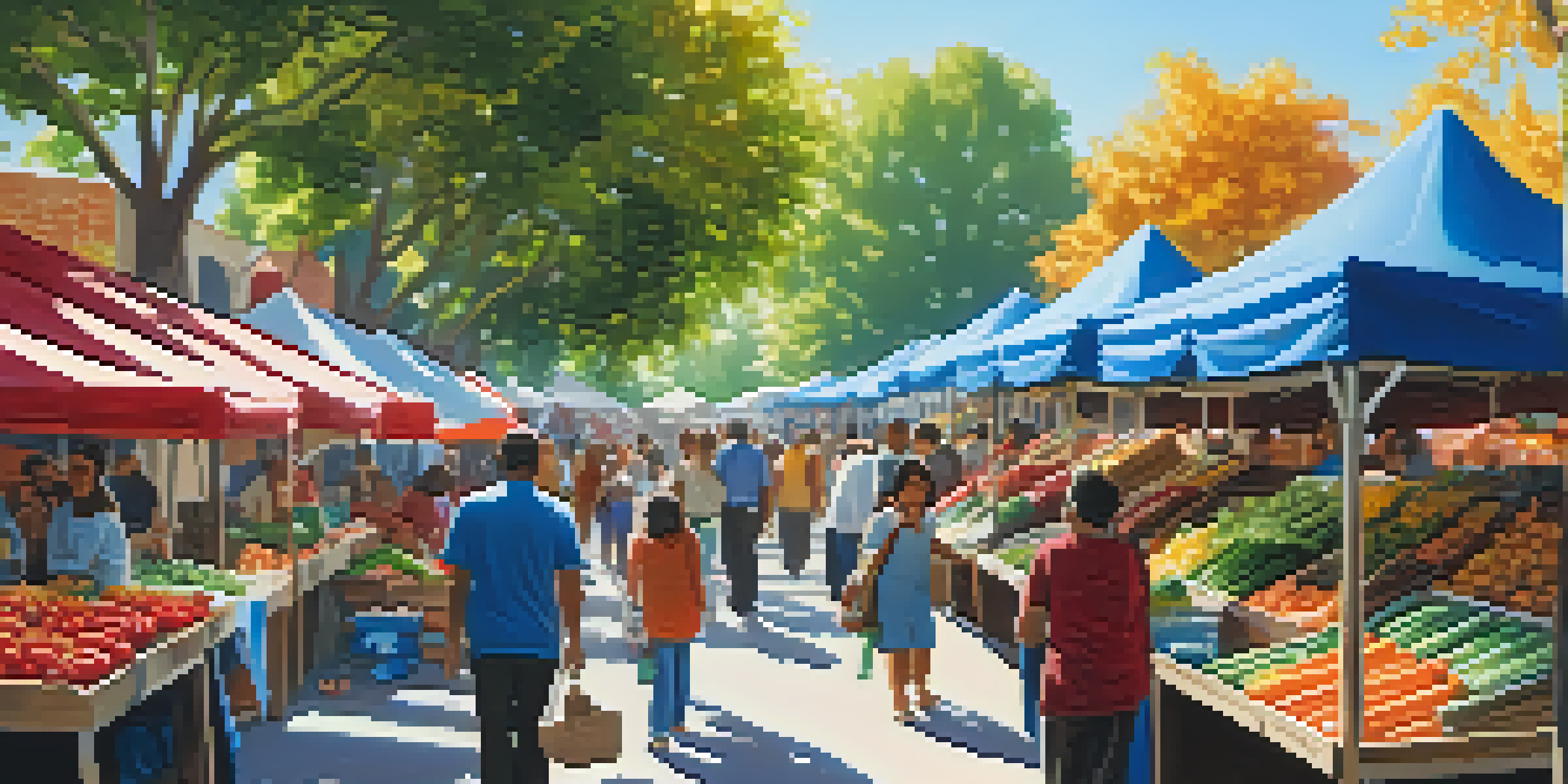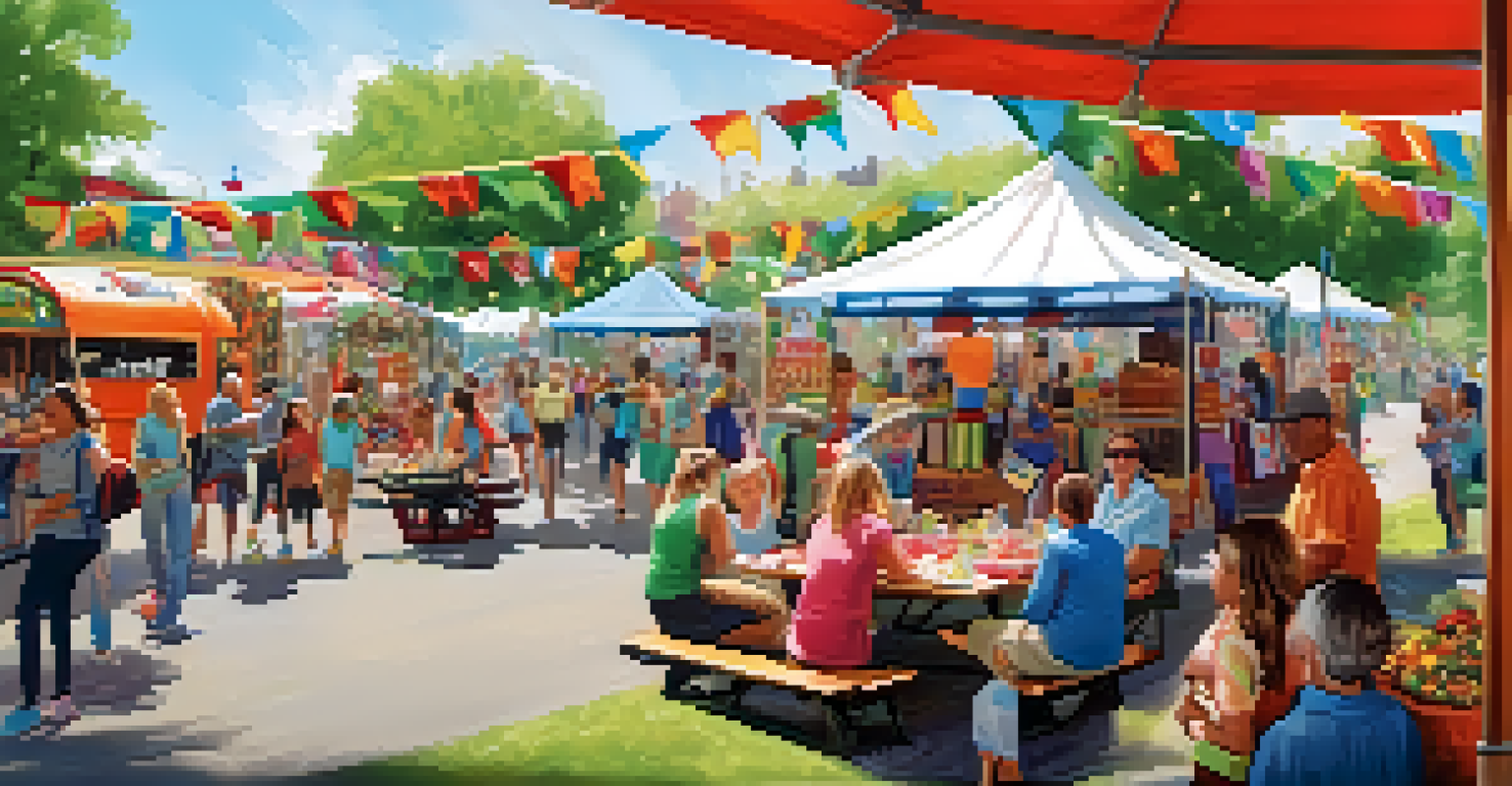How to Start Your Own Local Market or Fair

Understanding the Concept of a Local Market or Fair
A local market or fair is a vibrant gathering where community members can buy and sell goods, often featuring local artisans, farmers, and food vendors. These events create a lively atmosphere, fostering connections among residents while supporting local economies. Think of it as a cultural celebration where the community comes together to share unique products and experiences.
The best way to find yourself is to lose yourself in the service of others.
Imagine strolling through a colorful market filled with fresh produce, handmade crafts, and the aroma of delicious food wafting through the air. This not only enhances community spirit but also showcases the diverse talents and offerings of local vendors. Starting a local market or fair can be a rewarding way to engage with your community and promote local businesses.
As you venture into this project, it's vital to recognize that a successful market or fair requires thoughtful planning and dedication. You'll want to consider the types of goods you wish to feature, the size of your target audience, and the overall vibe you hope to create.
Researching Your Local Community Needs and Interests
Before diving in, conduct thorough research to understand the needs and interests of your community. Gather insights by chatting with local residents, business owners, and potential vendors to gauge their preferences. This will help you tailor your market or fair to what your community truly desires.

You might consider holding informal surveys or focus groups to uncover what types of products or activities would excite your potential attendees. Are people more interested in fresh produce, handmade crafts, or perhaps live entertainment? These insights can guide your decisions and ensure your event resonates with the community.
Plan Thoughtfully for Local Markets
A successful local market requires careful planning, including understanding community needs and selecting the right vendors.
Additionally, take a look at existing markets or fairs in your area. Analyze what they do well and identify any gaps that your market could fill. This way, you can provide something unique that draws in attendees.
Choosing the Right Location for Your Market or Fair
Location is crucial when it comes to organizing a successful market or fair. Ideally, you want a space that is easily accessible and has enough room to accommodate vendors and visitors alike. Think about parks, community centers, or even vacant lots that could transform into vibrant marketplaces.
Alone we can do so little; together we can do so much.
Consider the foot traffic in your chosen area. A location near popular shops or restaurants can attract more visitors, while also providing convenience for vendors. Additionally, ensure that your venue has adequate facilities, such as restrooms and parking, to enhance the overall experience for everyone involved.
As you evaluate potential locations, keep in mind that you may need to secure permits or permissions from local authorities. This process can take time, so it's best to start early to ensure everything is in place for your event.
Gathering Vendors and Products for Your Market
Once you've secured a location, it's time to gather vendors who will bring their unique products to your market. Reach out to local artisans, farmers, and food vendors who align with the community's interests. Creating a diverse lineup of vendors will enhance the appeal of your market and keep visitors coming back.
Consider hosting an application process for vendors to ensure a variety of products while maintaining quality standards. This way, you can select vendors who offer unique items that resonate with your audience. Highlighting local talent can also create a sense of pride and ownership among community members.
Engage and Entertain Attendees
Incorporating activities and entertainment can enhance the market experience and encourage visitors to stay longer.
Don't forget to provide clear guidelines and expectations for your vendors. This will help create a smooth and organized market experience for both vendors and visitors, ensuring that everyone understands their roles and responsibilities.
Developing a Marketing Strategy for Your Event
A well-thought-out marketing strategy is essential for attracting attendees to your market or fair. Utilize social media platforms, local newspapers, and community bulletin boards to spread the word. Create eye-catching graphics and engaging content that highlight the unique offerings of your event.
Consider collaborating with local influencers or community groups to amplify your reach. Their endorsement can help build credibility and interest, drawing in larger crowds. Hosting promotional events leading up to the market can also generate buzz and excitement.
Additionally, don't underestimate the power of word-of-mouth marketing. Encourage vendors and attendees to share their experiences on social media, creating a community-driven promotion that can lead to increased attendance.
Planning Activities and Entertainment for Your Market
To make your market or fair even more engaging, consider incorporating activities and entertainment. Live music, cooking demonstrations, or craft workshops can enhance the overall experience and encourage visitors to stay longer. Think of it as creating a mini-festival that celebrates local culture and talent.
You might also consider having designated areas for kids' activities, making your event family-friendly. This can include face painting, storytelling sessions, or interactive games that entertain younger attendees while parents shop.
Evaluate for Future Improvements
Gathering feedback post-event is crucial for identifying strengths and areas for improvement in future markets.
By offering a variety of activities, you create a dynamic atmosphere that can attract a wider audience. This not only boosts attendance but also enhances community engagement as families and friends gather to enjoy the festivities.
Executing and Managing Your Market Day Successfully
On the day of your event, strong execution and management are key to ensuring everything runs smoothly. Arrive early to set up and confirm that vendors are in place and prepared for visitors. Having a checklist can help you stay organized and on track throughout the day.
Designate roles among your team or volunteers to manage various aspects of the event, such as vendor support, visitor assistance, and activity coordination. Clear communication will be essential to address any unforeseen issues that may arise.

Lastly, remember to enjoy the moment! Engaging with visitors and vendors can provide valuable feedback for future events while creating a welcoming atmosphere that fosters community spirit.
Evaluating and Improving for Future Markets or Fairs
After your event, take some time to evaluate its success and gather feedback from both vendors and attendees. This can be done through surveys or informal conversations. Understanding what worked well and what could be improved will guide your planning for future markets or fairs.
Reflect on aspects such as vendor participation, visitor turnout, and the overall atmosphere. Were there any activities that particularly resonated with attendees, or were there logistical challenges that need addressing? Identifying these elements will help you refine your approach.
Continuous improvement is key to building a successful local market or fair. By being open to feedback and willing to adapt, you can create an even more vibrant and engaging event that the community looks forward to year after year.